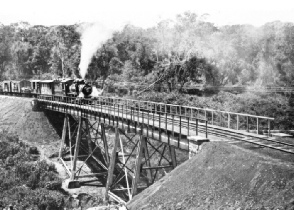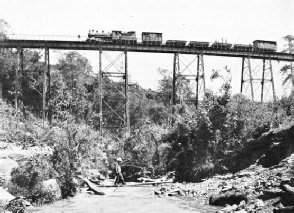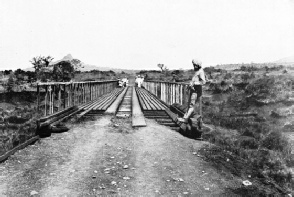The wonderful story of the Uganda Railway
RAILWAYS OF THE COMMONWEALTH - 23

A GLIMPSE OF THE UGANDA JUNGLE penetrated by the railway.
TWENTY-FIVE years ago, if one animated by the wanderlust essayed to cross the Dark Continent to the Victoria Nyanza he experienced adventure, sensation, thrills and excitement in plenty during a tramp of nearly 700 miles. One not only had to be a walking arsenal, but required an armed escort as well, for once the coast was left behind a “shooting iron” was as essential as a compass. The interior was not only thickly infested with dangerous big game of all descriptions, but the various native races, such as they were, displayed a more keenly developed preference for the arts of Avar than of peace. In addition, the Arab slave raiders found the country a rich field for the pursuit of their nefarious calling. Under these conditions the unexpected was likely to happen at any moment. The loads carried on their heads by the native porters were apt to be discarded suddenly to permit the frightened packers either to shin a tree out of the way of a lion, or to bolt into the bush from one of their implacable enemies. If the train were kept intact there were the risks of becoming stranded upon the waterless desert to suffer the pangs of thirst, while dependence, to a very pronounced degree, had to be placed upon Nature’s larder for the necessities of life.
But to-day one can pass from the seaboard to the waters of the remote interior in the luxury and comfort of the African equivalent of a Pullman car. The days of internecine warfare are over; the slave raider is but a memory; the only remnant of the exciting times of a generation ago is the game, which still is found in plenty.
The subjugation of British East Africa, more generally known as Uganda, was completed through the initiative of the British Government. It was realised from the first that little could be accomplished with this slice of the continent, aggregating 89,500 square miles, until a railway was built. But to drive a steelway through a new territory for some 600 miles, which was incapable of extending the slightest support, where there were no roads, with the markets thousands of miles distant and labour non-existent, was not to be undertaken lightly. It could be consummated only in one of two ways - by official assistance in the form of heavy constructional subsidies, or by the Government itself. A careful review of the situation proved the latter to be the only solution of the problem.
Accordingly, in 1893, a survey party was dispatched from the coast to make the preliminaries. The expedition was exciting and full of adventure. In the innermost stretches of the country the party encountered a certain amount of native hostility, and had their tussles with the wild denizens of the forest, as well as suffering the trials and tribulations incidental to the crossing of a waterless country. In due time they came back with a feasible location, but pointed out that everything was dead against the engineer, owing to the broken character of the country to be traversed, the necessity to introduce steep banks and sharp curves, and the difficulties that would arise from feeding those on the grade.

A TYPICAL VIEW UPON THE UP-COUNTRY SECTIONS OF THE UGANDA RAILWAY. Owing to the rolling nature of the country extensive bridging and heavy cuttings were required.
But the British Government was resolved to build the line at all hazards. It was estimated that the provision of the railway would involve an expenditure of about £3,000,000. This figure was based upon that of other British-built African railways of metre gauge, which was that selected for this line, and which was to be nearly 700 miles in length. In fact, one private firm of contractors offered to complete the undertaking for £2,500,000, provided they were given wide discretionary powers concerning gradients and curvature. This proposal, however, did not meet with official approval, and the authorities decided to complete the work by direct labour.
Mombasa was selected as the constructional base, the line being pushed inland from the seaboard. The remote distance of the markets from the constructional site proved a heavy handicap, because supreme difficulty was experienced in maintaining a steady supply of stores and materials.
The labour problem was more acute. The workmen knew nothing about work according to the white man’s interpretation. Whatever skilled labour was required had to be imported, mostly from India, and these men did not take long to realise, after their arrival, that they controlled the situation. Now and again the steadiness of toiling was rudely unset by small sectional strikes or attempts to take advantage of local conditions; but the threat to send the malcontents home generally sufficed to quell striking tactics, while attempts at hoodwinking the “boss” by loitering over the work did not meet with much success, as these efforts generally were met with the introduction of piecework rates.
The workmen’ way of doing things, too, often was a source of amusement and procrastination. They knew nothing about wheel-barrows, picks, steam-diggers, cranes, and other pieces of heavy artillery usually adopted by the railway builder. The basket was their favoured means of transport, and they used their heads instead of their backs for carrying purposes. Shifting a hundred pounds or so of earth at a time in this manner strikes the highly drilled scientific railway builder as distinctly primitive, but it is a condition of affairs which has to be tolerated.
One of the engineers who went out to Uganda from the United States to assist in the erection of the viaducts, and who met the African workmen at close quarters for the first time, was highly amused, and laughed long and loud at the primitive practices adopted; but he altered his opinion in the course of a few days. “Why, an embankment was like an ant-hill,” he confessed to me. “Those workmen swarmed in two continuous streams - one coming with loaded baskets from the cut, and the other going empty from the dump. They kept it up for hour after hour, and I guess that by the end of the day they had done more work than a dozen steam shovels and muck-trains. Why, hydraulic sluicing could not shift the spoil in heavier streams than did those workmen with their head-baskets.”

THE FOE OF THE RAILWAY-BUILDER IN CENTRAL AFRICA. During the making of the Uganda Railway the construction camps were raided frequently by lions, and at one time their persistent attacks stopped the work completely.
Owing to the coast terminus being at Mombasa, the first big work was the crossing of the channel to gain the mainland. For constructional purposes a timber trestle was laid down, the erection of the viaduct known as the Salisbury Bridge, 1,700 feet in length, being carried out at leisure. This bridge is of the trough type and supported on steel bents. The plate girders were riveted up on stages on the Mombasa shore and floated out to position between the piers on pontoons, and then hoisted into place.
From the seaboard the land rises brokenly and suddenly 530 feet in the first 16 miles. To overcome this difference in elevation a grade of 1 in 50 was found to be unavoidable. The country is thickly covered with jungle, these conditions prevailing as far as Maji Ya Chumvi, 35 miles inland, at an altitude of 570 feet. This is virtually the limit of the coastal belt, because from this point to Maungu, at mile 85, stretches what is known as the Taru desert, an evil country covered with a thick, thorny scrub. Even workmen and animals appear to dread this almost waterless, depressing tract, because it offers few evidences of being favoured by man or beast. Driving the steelway through this scrub, which presented a forbidding aspect, harassed the engineers sorely. Its evil reputation - for it was here that formerly many expeditions came to grief - scared the workmen. They could not overcome the dread that water would run out and leave them stranded to suffer the pangs of thirst. The builders placed capacious cisterns upon flat deck trucks, and established a regular water train service, because nearly every ounce had to be brought up 30 miles or so from the rear. In crossing this desert the railway makes a continuous climb of 1,130 feet in the course of 50 miles. On reaching Maungu, however, the physical characteristics change suddenly, the desert giving way to more inviting though heavily undulating country.
Although railway construction was carried out with supreme difficulty through this stretch, the first serious balk came when the Tsavo River was reached near mile 133. The waterway is not very impressive, though it has cut a channel between two lofty banks, while the bridge is not a big one as bridges go. It comprises four spans, each of 60 feet, carried on three substantial stone piers. The bridge is of the plate girder top-deck type, and, owing to the absence of the facilities generally available for such work, the setting of the steel had to be carried out on quite novel lines. The engineer in charge, Lieut.-Colonel J. H. Patterson, built up a temporary tower or crib with railway sleepers between the abutment and the first pier. From the top of this he laid heavy timber balks extending to the abutment and to the pier respectively. On these he laid a temporary track. Meanwhile, the plate girder span had been riveted up on the bank behind, and when complete was placed on railway trucks. The load was then carefully pushed over the gap spanned by the great balks, until it came dead into position between the pier and the abutment. Then the span of steel was jacked up off the trucks, so that the latter could be withdrawn from underneath. The jacks were then lowered until the steel came to rest upon the masonry, the timber balks and top of the crib work being lowered to allow it to be set. Each span was undertaken in this manner, and although the bridge occupied longer time in its erection than would have been the case had cranes or even a derrick been at the engineer’s disposal, the task was completed successfully and relatively cheaply.
 A STEEL TRESTLE BRIDGE on the Uganda Railway.
A STEEL TRESTLE BRIDGE on the Uganda Railway.
But it was not the setting of the steel which occasioned the delay, nor scarcity of labour, but a far more formidable foe. A large camp had been formed on the east side of the river, and work was proceeding quite uneventfully when a number of man-eating lions appeared upon the scene. They raided the camp, picked up sleeping workmen, and bore them away into the forest. Elaborate precautions and ingenious defences were thrown up to ward off the hostile inhabitants of the bush, but to no avail. These lions were among the most cunning that ever threatened an encampment. The labourers, unable to thwart the machinations of the beasts, grew alarmed, and resolutely refused to stay in the accursed spot unless an impenetrable and unscalable iron fence were thrown round their precincts.
Through the lions construction was brought to a standstill, and the ill-fame attached to the neighbourhood of the Tsavo River became noised so far and wide that no man would volunteer to go to the bridge unless the lions were exterminated. Lieut.-Colonel Patterson essayed the task of fighting the animals, but it proved as stiff and as unequal a combat as ever man attempted. His subjugation of the man-eating lions constitutes one of the finest stories in the history of big-game hunting, and he has related his endeavours and successes in a wonderfully thrilling volume, “The Man-Eaters of Tsavo”.
Although he finally succeeded in ridding the country of this terror and restored confidence in the minds of his workmen, it was not before the voracious creatures had devoured twenty-nine Indian workmen and no one knows how many workmen.
Still climbing, with grades ranging from 1 in 100 to 1 in 66 and 1 in 50, making sweeping curves, striking across deep rifts and through deep cuttings hewn out of massive shoulders, and describing big loops a mile or more in length to ascend a few feet, through rolling and open country and dense jungle, the railway reaches Nairobi 327 miles out of Mombasa, and 5,450 feet above the sea level. Here the climate is delightful, cool, and even bracing. As this is practically the half-way house between the coast and the inland lake terminus of the railway, while its situation is so attractive and congenial to the white men, it was selected as the head-quarters of the railway. There is a well-built station, replete with every convenience, commodious yards, stores, engine sheds, and workshops. Incidentally one is given a compelling and intimate illustration of the vast changes that have been wrought by the railway during a single decade. In the shops may be seen African workmen who, less than ten years ago, lived by war or herding cattle with only beads and fearsome colour-smears on their bodies as clothing, now engaged in wielding hammers, blowing forges, and working with machine tools to build engines and other rolling stock, as well as fashioning the thousand and one other articles demanded by a big and important railway. The rapid and thorough conversion of the workmen within such a short space of time offers one of the most convincing instances of the power and capacity of the British in colonising. On all sides of the station, as far as the eye can reach, are evidences of enterprise and industry. The virgin belt has been reclaimed and converted into farms. Large herds of cattle roam the rolling grass-land, recalling the huge ranches which were so plentiful in North America twenty years ago. Tall, rank grass has given way to cereals; the useless scrub has disappeared in favour of economically useful vegetation; the Ugandan has discarded his rude, primitive garb, and now stalks about in the western dress, somewhat bizarre and weird in its harmony perhaps, but civilised for all that.
 THE MAKING OF THE UGANDA RAILWAY: ready for the rails. A bridge completed and the grade finished to foundation level.
THE MAKING OF THE UGANDA RAILWAY: ready for the rails. A bridge completed and the grade finished to foundation level.
You can read more on
“Pioneering in Nyasaland”
and
“Through Desert and Jungle”
and
“The Uganda Railway 2”
on this website.





 A STEEL TRESTLE BRIDGE on the Uganda Railway.
A STEEL TRESTLE BRIDGE on the Uganda Railway. THE MAKING OF THE UGANDA RAILWAY: ready for the rails. A bridge completed and the grade finished to foundation level.
THE MAKING OF THE UGANDA RAILWAY: ready for the rails. A bridge completed and the grade finished to foundation level.